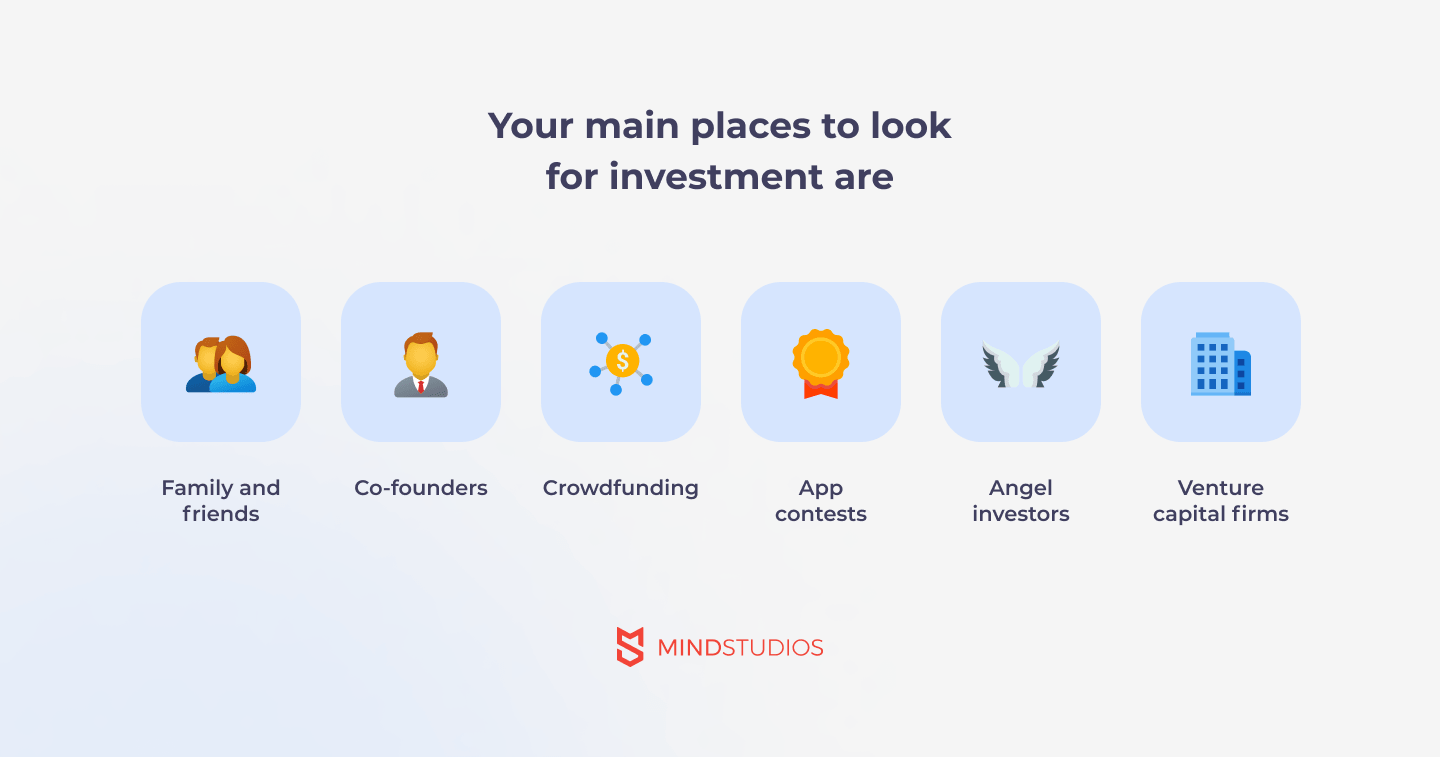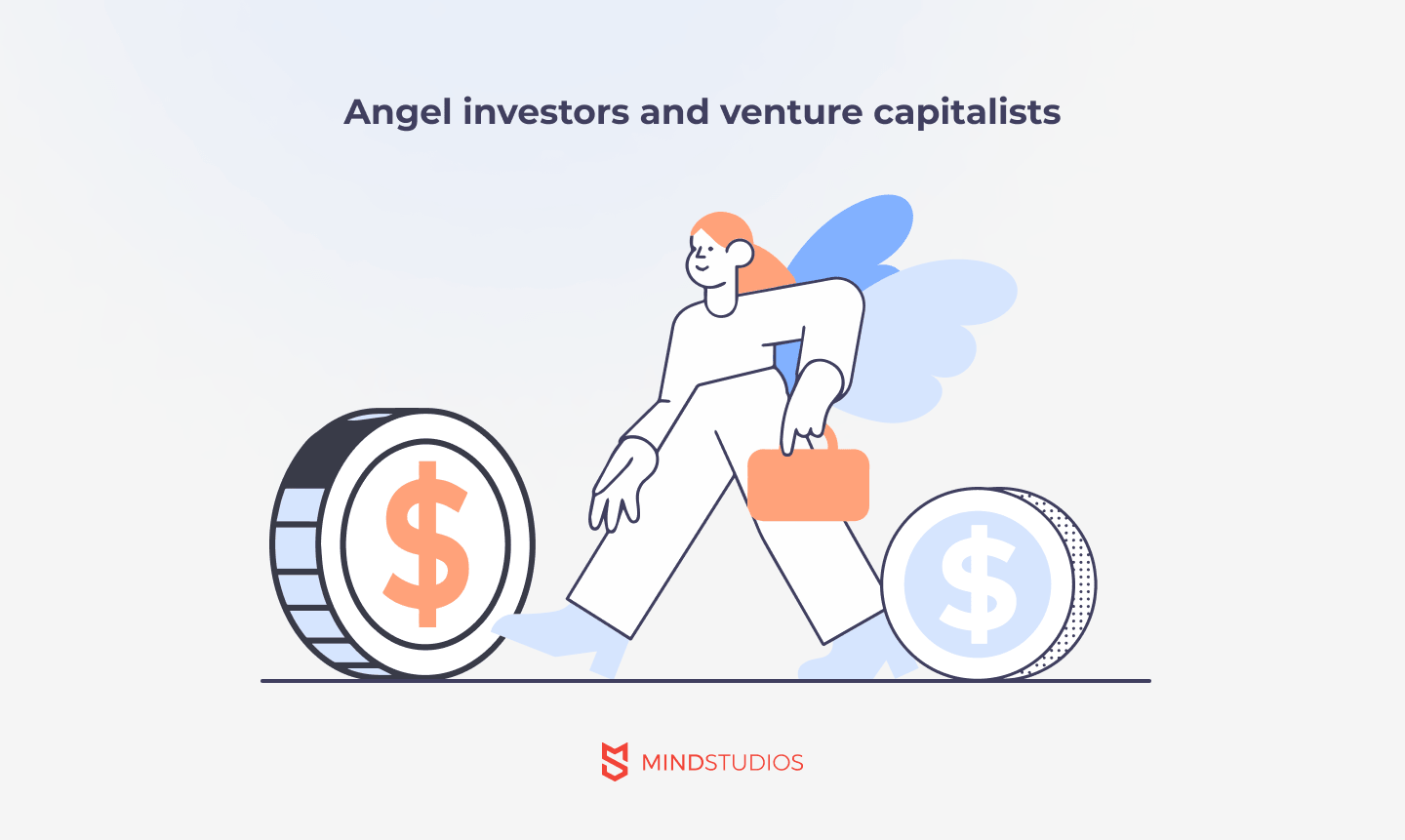How To Get Investors For An App
The market for mobile apps is lucrative, and everyone with an idea wants a piece. It's a good thing. However, to build a high-quality mobile app, you need significant funds.
In this article, we share how to find investors for an app. Based on our experience, we'll offer advice on how to make potential investors more willing to fund your project.
What kinds of investors are out there?

If or when your own money doesn't cut it anymore, it's natural to look for sponsorship. The market offers a variety of ways to get funded. Depending on your app idea, the stage you're at, and how much money you need to bring your idea to reality, you'll need to look for investors in different places and pitch your ideas in different ways.
Your main places to look for investment are:
-
Family and friends
-
Co-founders
-
Crowdfunding
-
App contests
-
Angel investors
-
Venture capital firms
Family and friends
Those near and dear are usually the easiest to convince that our ideas are worthy; these are the people who love us and believe in us. However, in most cases, personal connections can sponsor a startup only at the very beginning. Usually, with investments from your closest connections, you can do research and maybe build a mock-up, a rough prototype, or a demo to show other possible investors you mean business.
Co-founders
Oftentimes, you can find co-founders among family members and friends. It's an alternative to simply borrowing money from the same people. When opting for co-founding, you won't need to give money back directly but instead will share the revenue when your app starts bringing it in.
Investment via co-founding can also result in a more significant sum of money than borrowing. When a person is convinced an idea has enough potential to co-found it for a share in profits, they're likely to invest more.
You can also find people to co-found your startup outside your existing connections — among local business owners or even online, for example. This does bear more risks, though, so remember to background check strangers willing to invest in your app.
Crowdfunding
Crowdfunding mobile apps is a fairly popular option today. It combines two important benefits of other types of investment without their downsides:
-
Crowdfunding has the potential to get you more money than your family can likely provide.
-
You won't necessarily need to give up shares in your business as you would with co-founders, angel investors, and venture capitalists.
Instead of giving up shares, you can offer your crowdfunding patrons early access or Premium perks for free.
However, for a successful crowdfunding campaign, you'll need to invest time, effort, and most probably money in marketing. Spreading the word about your mobile app is of utmost importance with crowdfunding.
App contests
This is an option for startups that already have developers, whether in the form of in-house teams or hired outsourcing companies. A number of app development investors take part in funding contests for mobile startups every year. Most of these contests take place in the US, but others happen around the world. By taking part in such a contest, you'll receive a number of benefits even if you don't win the grand prize:
-
Experience pitching your idea
-
Information on competitors and how they run things
-
Exposure with a chance of catching the eye of potential investors outside the contest
On the flip side, in a contest, you'll have numerous competitors, and standing out from the crowd will be of utmost importance. Besides, taking part in a contest can be pricey. Before you enter an app contest, weigh all the potential pros and cons.
Angel investors and venture capitalists

When it comes to a serious infusion of money into a mobile startup, it's angel investors and venture capital companies you should look for. These are entities that usually offer bigger sums of money.
The catch is that they'll ask for a share in the business in return.
The difference between angel investors and venture capitalists is that the former are more often individuals and the latter are usually companies. For this reason, venture capitalists offer more money than angel investors and, consequently, tend to ask for a bigger part in the business.
Venture capitalists step in at Series B and later rounds, too, while you can usually find angel investors at the seed round.
Also worth noting: Today, a possible solution for startups is to enroll in a business incubator. Incubators are companies that help startups get ready for growth, for which seeking investment is an important step. Among other things, some incubators end with a contest where the prize is a significant amount of money.
What are funding rounds?
Often, it's not enough to have one investor pour money into your startup once. As your business grows, you'll probably need more investments to speed up that growth. That's why the investment process is usually divided into rounds, each with its own rules.
Over time, funding amounts offered by investors have grown significantly, especially in the last couple of years. Here's some data from the Fundz 2020 report.
| Round | Who usually takes part in it | Average investment amount |
|---|---|---|
| Pre-seed |
| Any amount available for startup owners without going to unrelated parties |
| Seed |
| $2.2 million |
| Series A |
| $15.6 million |
| Series B |
| $33 million |
| Series C and beyond |
| $59+ million |
| Initial Public Offering (IPO)* |
| Any amount is possible |
*An IPO means you offer shares in your company to anyone willing to buy them. However, companies going for an IPO need to meet strict requirements set by the US Securities and Exchange Commission (SEC).
How to get investors for your idea
Taking loans from family and friends usually requires you to believe in your startup and have at least a vague idea of what you're going to do. You'll still need to do some research to convince people to support your venture, but it's significantly easier than stepping into the seed round and meeting professional angel investors and venture capitalists.
Since angel investors and venture capitalists provide considerable investment and with it take serious risks, it's not an easy task to get them on board with your idea.
What do you need to do to get investors for your app? Here are our recommendations.
Have a competitive advantage
According to Investopedia, 75% of all venture-based startups fail. These statistics make investors understandably wary of backing new businesses. The chances of failure rise when your business is similar to an existing and popular company — luring customers away from a reputable service is no small feat.
The sharpest drop in "survivors" among startups is usually expected during Series A, even for startups with very promising ideas. Mostly, startups fail due to a lack of strategic planning for where to put money first.
Therefore, the least you can do to persuade investors to back you is to conduct thorough professional research into your niche and come up with
-
a unique solution to users' problems that's not addressed properly by existing service providers
-
a strategy to address the problem and lure in users with the help of investment
For example, let's consider dating services. No one will back a Tinder clone, but many find Tinder lacking in several ways and are looking for an alternative. Find out what makes Tinder users unsatisfied and create a dating app that will satisfy them.
Have a brand identity for your app

For investors, it's important to know that you're approaching your business seriously and understand what you're doing. One way to show that is to design a brand identity.
A brand identity is the visual showcase of your brand. However, it's more than just a logo. A brand's identity is also its "personality" of sorts: how you will communicate with your audience, your brand voice, philosophy, positioning, and purpose.
A catchy, easy-to-remember logo doesn't hurt either.
Having full branding to show possible investors pursues two main objectives:
-
It shows that you've thought about and planned your business to a certain degree.
-
It helps investors visualize the product.
Branding might be subject to change — either according to suggestions by investors or to stay relevant in the fast-paced environment. However, you need to be prepared to show your commitment to your project in order to get the attention of investors. Having presentable branding is one way to do that.
Prepare an elevator pitch
Snagging a somewhat lengthy appointment with a reputable investor is hard. Investors are fewer in number than startups seeking their help. This is why the elevator pitch exists.
An elevator pitch is a very short presentation of your idea. It's called an "elevator pitch" because it should be short enough to present to someone as they ride an elevator to their floor.
An elevator pitch takes about 30 seconds to one minute. In this time, you need to introduce yourself and your project in a way that makes someone interested in hearing more.
In 30 seconds to one minute, you need to state solid facts about why your idea is unique, competitive, and potentially lucrative and only needs some investment to bloom. To manage that, you need to come prepared. So draw up a plan and memorize what you're going to say. Stress the most important parts of the business: its purpose, how much demand there is for the service it provides, the planned monetization model. Practice your pitch.
Of course, it's not that you'll have to ambush an investor in an elevator. Investors hold special meetings where everyone vying for their money presents their projects. Those who do it well get a chance to hold a longer (about 20 minutes on average) personal meeting and present a pitch deck.
Prepare a pitch deck

If your elevator pitch is successful, you'll get a chance to meet your possible investor(s) for a longer conversation where you'll have to present a fuller report on your business and try to persuade them to fund you.
A pitch deck is simultaneously easier and harder to present than an elevator pitch. It's easier in that you've got more time and you can carefully arrange all the data to look as good as possible. It's harder in that you'll need to know what data to present and how, and you'll have to be ready to answer a lot of questions.
A typical pitch deck is made in a presentation or a slideshow, usually containing nine to twelve slides. It's recommended that you keep within these limits, as too long a presentation can result in investors getting bored. If they need additional information, they'll ask.
Getting investors for app development is essentially the same as trying to pitch any other kind of idea. Here are the most important things to keep in mind.
-
Get your numbers straight. Investors (other than family and friends) give you money in exchange for part of your business, meaning they expect that business to bring profits. To gauge the possibility of profits, they need you to provide them with an estimate:
- how much it costs for you to acquire a customer
- how much you've made since launching your business
- how much money you need from investors
- how much of the investment you plan to spend on what (development, mobile app marketing, etc.)
- what your monetization model is (how you're planning to make money)
- how much you plan on getting in revenue in the near future (half a year to a year)
-
Know your niche. You will inadvertently be asked about the competition and what you plan to do to get ahead. This is where your competitive advantage comes into play. To get funding for an app, a startup needs to know what they're up against and how to snatch a win from rival companies, many of which might have been on the market seemingly forever.
-
Have a business plan. When funding a startup, especially if it's your first project, it's important for investors to see that you're not going to run around throwing money at anything and everything at once. Investors need to know that you've prioritized app features, chosen marketing strategies and platforms, and understand your team's needs. Present a growth plan your business will follow, given the money.
-
Make your pitch memorable. Most reputable investors hear dozens of pitches one after the other, so to catch their attention yours needs to stand out. Besides, investors might not make a decision right away. That's not to say you need to do acrobatics, of course. Make your pitch memorable with:
- enough visuals in your presentation to share your vision
- passion about your app idea so investors understand you're fully committed
- a branding identity that's distinct and easy to understand
- a landing page (preferably with visitor statistics)
-
Get real. Unrealistic expectations are a major turnoff for investors. They show a lack of forethought and analysis. Your idea probably isn't completely new or original, and chances are high that someone else either came up with it already or will very soon. Your bargaining power is in being the first to bring it to investors, but you need to keep in mind that it's not enough to just come up with an idea for mobile app investors to jump on board. You need to set realistic goals and know how to reach them.
Have an MVP

A minimum viable product (MVP) isn't a must-have for a pitch deck, but it can be the ace up your sleeve when you're pitching your mobile app to investors.
Business people love nothing more than a business that already works, has customers, and whose owners have invested time and their own money into it.
Even if it's a very simple version — an interactive prototype or a barebones app — mobile app investors will look more favorably on it. You can offer your potential investors to try interacting with the mock-up, tell them what led you to this particular user flow, share how your test group received the prototype, and so on.
A prototype or an MVP is a show of your dedication, and, in the case of a working MVP, an additional source of revenue.
Bottom line
Funding a mobile app is a daunting task for startups with little or no experience. Sometimes, it takes what seems like ages to find an investor. New solutions emerge every day, and time is a luxury few startups have. Sometimes, the best way to find investors is to ask someone who's done it before.
At Mind Studios, we've worked with numerous startups, and some of them have acquired investments. Moreover, we invest in some of our projects as well. We know how to find investors for an app and have experience preparing to pitch ideas.
How To Get Investors For An App
Source: https://themindstudios.com/blog/how-to-get-investors-for-your-app-idea/
Posted by: wynneagre1952.blogspot.com

0 Response to "How To Get Investors For An App"
Post a Comment